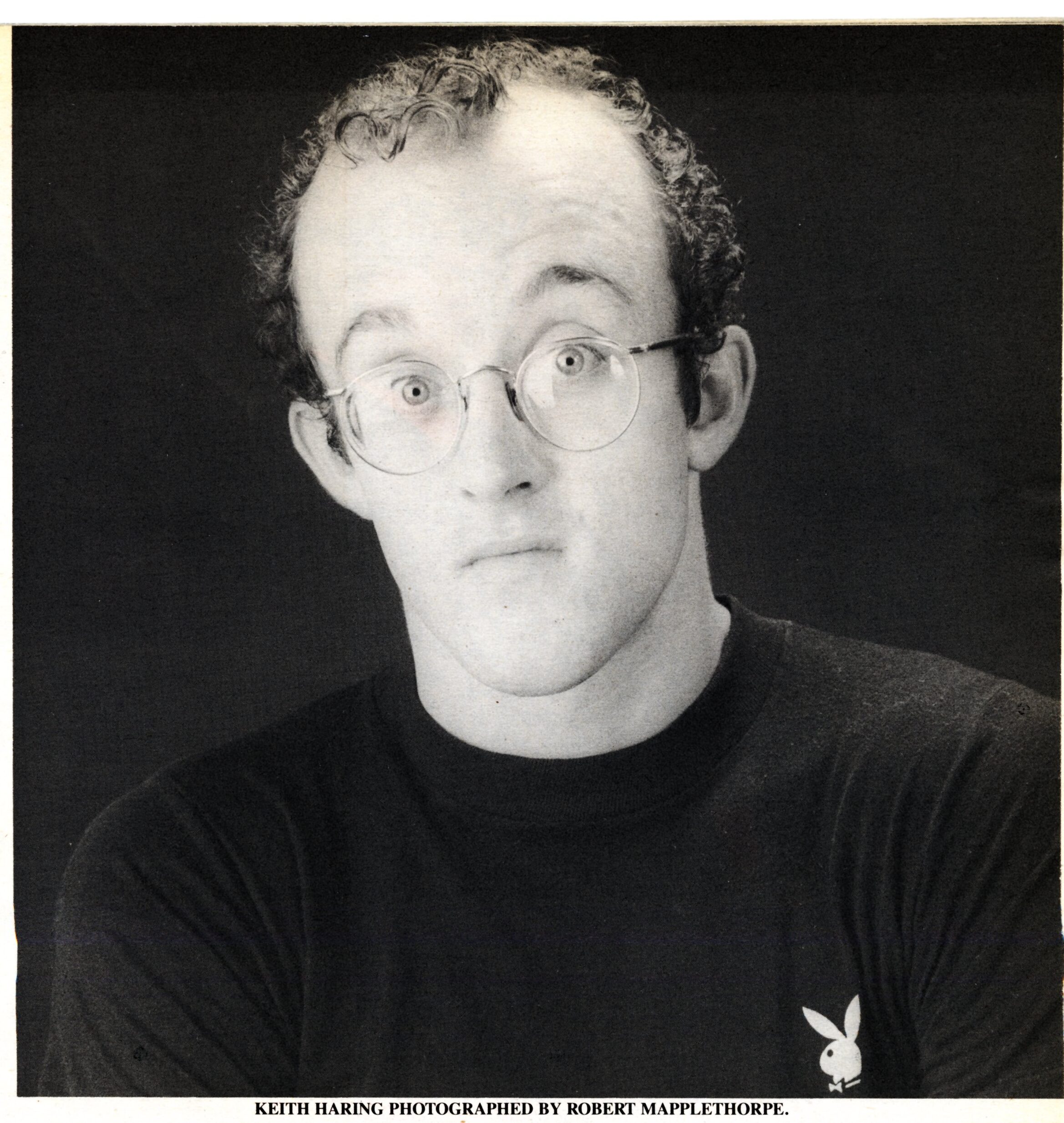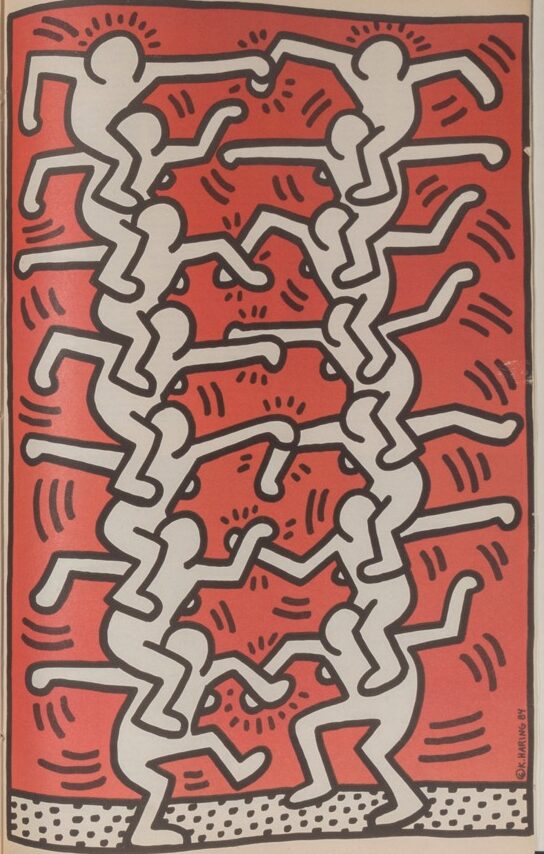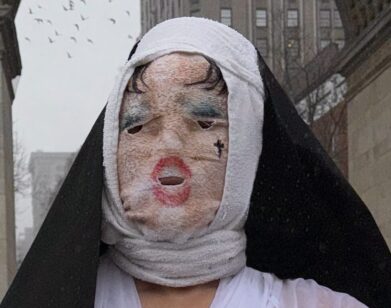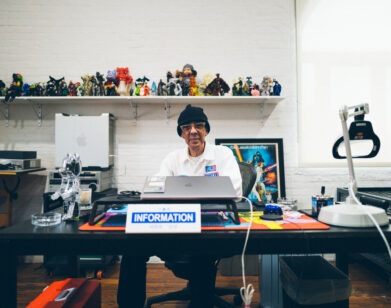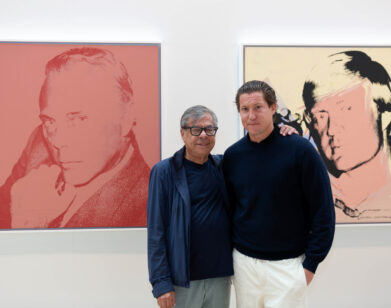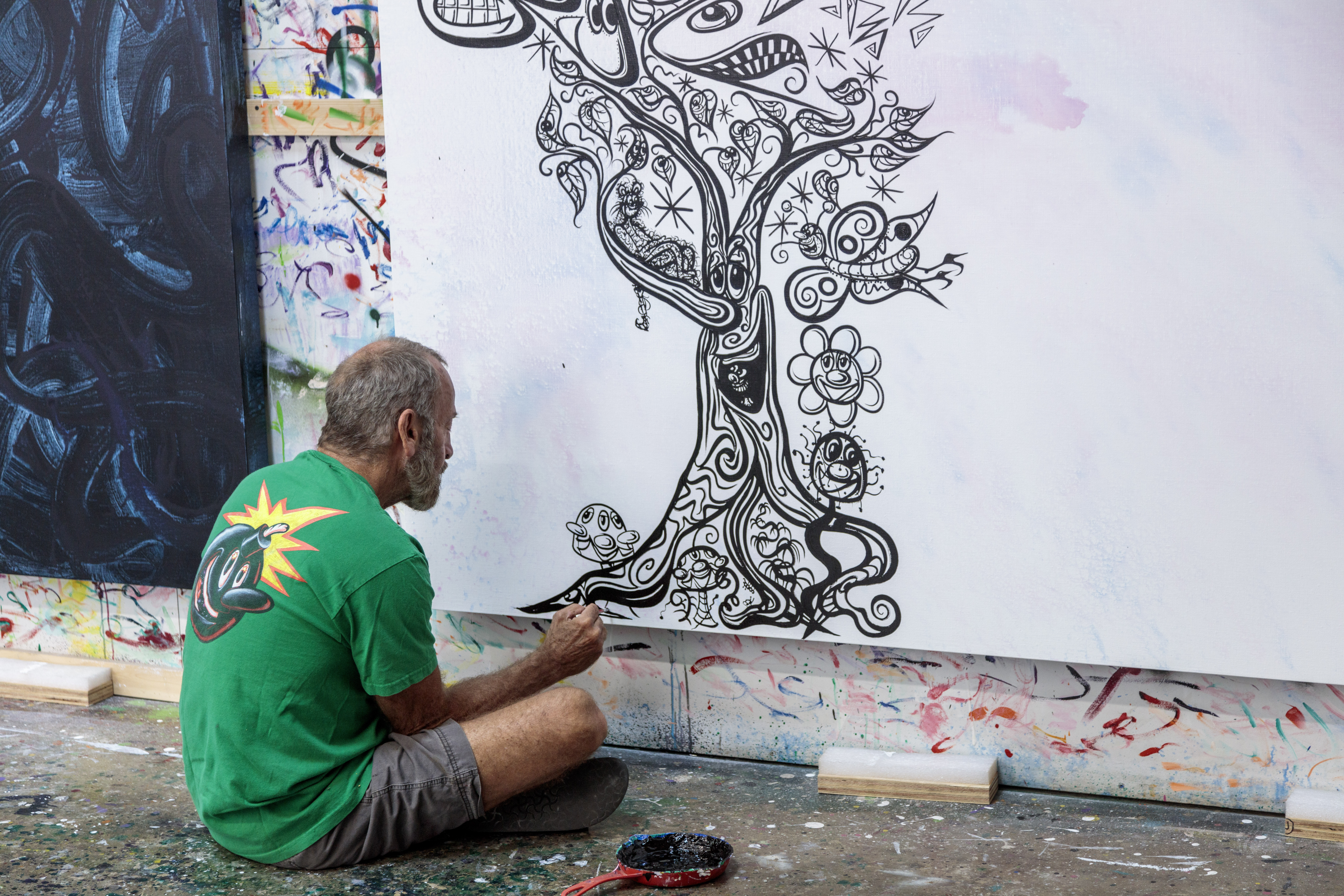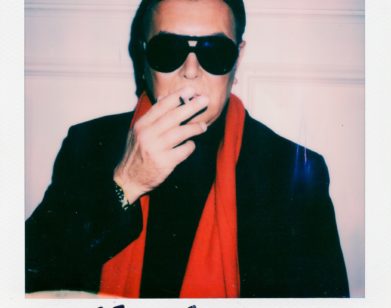PARADIS ICONS
A Taste of Paradis: Keith Haring, in Conversation With Halston, Warhol, and Philip Johnson
Over its 258-year history, Hennessy has pioneered and elevated the art of cognac, a spirit fit for kings and queens. Interview Magazine hasn’t been around quite as long – just 54 years – but we like to think we, too, have curated conversations and photography that aspire to a similar level of elegance and sophistication. In honor of Hennessy’s storied Paradis marque, we poured through the Interview archives to recirculate conversations with personalities, entertainers, and icons who personify the brand’s spirit of refinement, grandeur, and artistry. Today, we revisit the December 1984 issue, where the late downtown legend and Pop Art icon Keith Haring dug deep into the allure of hitchhiking, small town exoduses, and the power of street art with two other art world icons, the mononymous fashion icon Halston and the profound, prolific, architect Philip Johnson.
———
FROM I.R.T. TO A.R.T.
In the progression of artistic movements from Expressionism through Pop, the figurative work of Keith Haring stands out as an exceptional step forward. Incorporating the simplicity, frivolity and humor of Pop, Haring has gone further to invent an original vocabulary of symbols at once recognizable and evocative—the crawling baby, barking dog, portable pyramid, zapping spaceship—sometimes done on canvas, more often chalk-drawn on subway station ad boards, buildings or sidewalks. Free of specific cultural references, the drawings speak with equal clarity to sophisticated viewers and mere passersby, in a deeply human voice.
Raised in Kutztown, Pennsylvania, Haring came to New York in the late ’70s and attended the School of Visual Arts. Soon discovering that the “most beautiful paintings in the city were being shown on wheels (by the graffitist),” Haring began his subway drawings as a lark, and became a celebrity underground and above, with his first gallery exhibition in I98I. In spite of the proliferation of international showings and press since then, including the recently published photographic study “Art in Transit“ (Harmony Books), the artist and his work have maintained their charming innocence. These no interviews, the first with designer Halston and Andy Warhol at a weekend house in Montauk, the second with Philip Johnson at the architect’s home in Connecticut, offer a stereoscopic view into Haring’s special world.
HALSTON; When did you start drawing?
KEITH HARING: When I was four years old. Everybody draws when they are little.
ANDY WARHOL: I drew flies.
HALSTON: You drew flies?
AW: Doesn’t everybody draw flies?
HALSTON: Do you do work for TV?
KH: I got asked one time to do the graphics for the Pan-Am Games.
HALSTON: You should do them.
KH: I wish I had done something for these Olympics, it would have been great to have done a huge running man on top of the Coliseum or something.
HALSTON: You should do a comic strip. Did you ever do a comic strip?
KH: No, not really. I’ve been drawing cartoons since I was little but…
HALSTON: Walt Disney could use a new character.
KH: I’ve always wanted to work for Walt Disney: That’s what I thought I was going to do when I grew up
AW: The crawling baby could really be a good daily comic strip.
KH: Except I think that would ruin it. I think when you turn things into serials like that it ruins it.
HALSTON: What if you make a movie out of it?
KH: When they put Snoopy and Peanuts on television it just ruined it.
HALSTON: Well, then you could go into crawling teenagers and dolls and things. And the women and old people.
KH: Speaking of old people, I did a thing for a medicine company in Germany to advertise a heart medicine.
HALSTON: A heart medicine? What kind?
KH: It’s a new heart medicine, I forget what it’s called. It’s for cardiac arrest.
HALSTON: I like it just called “heart medicine.”
KH: They used some of my drawings to promote their product in medical journals and things. It’s funny, I get the weirdest offers.
HALSTON: What’s the weirdest offer you ever had?
KH: I had a call from a firm that represents the polyester industry. It had to do with a big media event to try to get polyester back on the map.
HALSTON: I never thought it left the map. You’ve done a book already?
KH: I’ve published one book with Tony Schafrazi. It was sort of like a catalog, not really a book. I have a book coming out now that I did with Harmony Books, of photographs by Tseng Kwong Chi of the subway drawings from the last three years with a foreword by Henry Geldzahler. Actually, I have a great picture of me with Mayor Koch, as I present him this book and he makes this really horrible face. like, “Who is this guy and how did he get in my office?”
HALSTON: I saw him on TV the other day saying that he hated graffiti. But you don’t consider yourself a graffiti artist,
KH: Mayor Koch hates it a lot. What I call it doesn’t matter because the media calls it graffiti.
HALSTON: What would you prefer calling it?
KH: I call it drawing. It was ironic that I got to meet the mayor because of that litter pig thing. The Sanitation Department has a new anti-litter campaign for the city called “Don’t Be a Litter Pig” and they asked me to design the pig for it. I had to do this press conference with him for the anti-litter campaign. So I took the opportunity to give him the book and sort of confront him with it. He had to accept it and shake my hand because I was there to do something free for the city.
HALSTON: It costs ten million dollars a year to remove graffiti, doesn’t it?
KH: Yes, but it’s really a waste of money because they’re not going to wipe it out anyway. They can’t stop it. All they do is chase the good artists off the trains.
AW: What’s the difference?
KH: The trains in 1978 and 1979 were incredible. That’s when an artist would spend eight hours on one car. No one does that anymore. Every now and then you see a piece, but now they have these huge buffing machines with a chemical wash that they run the trains through. No one will spend the eight hours if they’re going to have their piece ruined in two days.
HALSTON: Where did you grow up?
KH: I grew up in Pennsylvania in a small town. Real small, like one high school and one movie theater. Well. there was a state college there, that was the only good thing about it.
AW: When I came to New York I had one dish, one spoon, one fork. It’s actually more fun to have one school, one post office.
KH: It made everything simpler, except that everybody knew you and everybody knew everything you were doing. And for me that wasn’t good because I started my childhood being a really good little kid: churchgoer, straight-A student, little league team. And then by the time I was fifteen and wanted to be a hippie…
AW: What made you want that?
KH: I guess being a little bit progressive by myself and just reading Life magazine and seeing Woodstock and the Democratic convention in Chicago on TV, things like that. It got to the point where I wanted to smoke pot so bad I bought tea. When I was thirteen or fourteen, I tried to smoke tea hoping that would do something. I had no idea where to get pot from. Soon after that I found out where to get pot, So l started to hang out with college students when I was about fifteen, and that’s how I got to experiment with other things And then I started hitchhiking and getting out of the town when I was 17.
AW: Where did you go, Philadelphia?
KH: No, usually to the New Jersey shore. And one summer I ran away and lived at the Jersey shore for the whole summer because my parents refused to let me go work there? So I just did it anyway.
HALSTON: What kind of work did you do?
KH: I was a paperboy when I was little, so I was always saving money. From the time I was twelve years old, I was buying savings bonds. So years later I took a thousand-dollar savings bond, bought a half-pound of pot and moved to the shore. I spent all the money and had the best time of my life. It was really great because I learned a lot and grew up and learned how to live with people and live by myself.
HALSTON: Were you drawing all the time?
KH: Yeah. I was, but I wasn’t taking it all that seriously.
HALSTON: When did you take it seriously?
KH: I guess as soon as I started thinking of art and not cartoons, when I was 17 or I8.
HALSTON: What was the first thing you sold?
KH: I sold little things when I was young.
HALSTON: How much money did you get for them?
KH: The first thing I sold I got $135. That was when I was 17. It was a little ink drawing of a map of Berks County. When I was 17 I hitchhiked to New Jersey to go to this art exhibition on the Wildwood boardwalk. I took my little portfolio with me and was in this art show. It was the kind of show they have in shopping malls with all these really tacky crafts artists. But I got a prize and was real proud and sold a few little pen and ink drawings. I was hitchhiking to Beach Haven in a car with this guy who said he was going almost all the way, and the portfolio was in the back seat. All of a sudden he changed his mind and was going a different way, so I had to get out really quick, and there was a line of traffic. I got out and left the whole portfolio of my work on the back seat. I never saw it again, and it was everything I had done up to that time. I just started all over and everything got better. Things like that happen to me a lot. I just want to go forward, forget about it and do something different. It just seemed like it kept getting better.
AW: You did the baby on Union Square, didn’t you?
KH: That wasn’t until 1981 or ‘82. I didn’t start doing graffiti until two years after I got to New York. Jean Michel Basquiat was one of my main inspirations for doing graffiti. For a year I didn’t know who Jean Michel was, but I knew his work.
AW: And he actually went around writing poems on the street?
KH: Yes, it was like the first literary graffiti.
AW: What are the kinds of things that he said?
KH: Samo became a philosophy. “Samo” supposedly stood for same old shit. That was in the Mudd Club days.
AW: Jean Michel is a really good writer. He writes beautiful poetry.
HALSTON: Do you like to write, too?
KH: Sometimes, yes. I used to keep a diary, but I stopped. I really wish I’d have kept it up. I was keeping a diary when there wasn’t anything really interesting happening, and now there’s so much happening and no time to sit down and write about it. Artists’ diaries were always my favorite things to read. Like Rimbaud and all those people.
HALSTON: Now you’re doing things all over the world.
KH: Yes, for the last two years.
AW: What’s so good about him is he can go and take his art with him and do it there.
HALSTON: You do it right on the spot? You mean if you’re going to have a show in Japan or something you do it right there?
KH: I went to Tokyo for three weeks and made everything there. I didn’t even take any brushes with me. I bought everything there.
HALSTON: Do you do commissions?
KH: Not really. A lot of people ask me to do things inside their houses, but I rarely will do it because there are so many other chances to do things. I do commissions for the public, but in a private house it doesn’t seem like it’s worth the time, because not that many people will see it.
HALSTON: What would you like to do next?
KH: Everything. I’m working on sets now for a performance with Bill T. Jones at the Brooklyn Academy of Music. I’m going to do a set for Roland Petit for his new ballet in Paris, which is cool, because he’s had a lot of great people do sets for him. Picasso did a set for his first ballet when he was 20, and he’s used Max Ernst and Miro and Jasper Johns and David Hockney. David Hockney did his last set. That will start in the spring and probably not be in New York for two years.
HALSTON: You want to be in the fashion business too, don’t you?
KH: I feel like I’m capable of it. You have to have either someone else working for you to set up the whole thing or you have to devote a large chunk of your time to doing it. There are endless possibilities. There’s not enough time for me to do all of it. That’s probably why I’m getting ripped off and imitated so much by people. I guess if I can’t utilize it, someone else has to. In some ways I don’t really mind if people do it, because I can’t do all of it myself. There are other people making jewelry and other things out of my characters without my permission. Almost every country I’ve been in already has Keith Haring T-shirts whether I’ve made them or not.
HALSTON: You could license it. When people copy you it just makes you more known.
KH: I guess, but then it’s out of your hands and you don’t really have quality control.
HALSTON: You can do quality control.
KH: I’m taking all that real slow because right now I’m more interested in doing children’s books and animations and theater sets, expanding in lots of other directions. I’d still love to do a playground. I saw Noguchi’s playground and it was so incredible. I think it’s one of the best things he ever did. I know I could make an incredible playground.
HALSTON: You should do a Diana Ross playground.
KH: I would do it.
HALSTON: Actually, you should get the Mayor to do that.
KH: I’d like to make it out of huge cast rubber so you could bounce off it. It would be really sturdy, but you could climb all over it—huge sculptures.
AW: Your sculptures were great.
KH: The first ones were those totem poles. That was a sort of primitive attempt at doing sculpture. The headdress we made for Grace Jones was another step, really, because it deals with the inside space instead of just the surface.
HALSTON: How do you deal with the fact that you are not a starving artist anymore and your community still is starving artists?
KH: I guess you find out quickly who your friends are. The people who were my real friends before never lost any respect for me because of what happened to me. And the people who only were acquaintances… I guess a lot of people resent it or can’t handle it now. Most people want to be cool and think that as soon as something is popular that means that it’s “sold out” or it’s dangerous. So they have to move on to the next thing that’s unpopular and still cool. I don’t find any conflict between the two things. The audience I was trying to reach I’m still reaching. Those people that are upset about it aren’t the people I’m interested in anyway.
[at Philip Johnson’s]
KH: Is it true you were going to make a building in Manhattan with a moat around it?
PJ: The Trump Castle. Well, a castle has to have a moat, doesn’t it? I had to set the thing back from Madison Avenue, so I put a moat around it and put a drawbridge across.
KH: The moat would surround the entire building, the whole block?
PJ: Not the whole block, but whatever piece of property I had. So it would give you the feeling of these great towers rising out of the moat.
KH: How deep would the moat be?
PJ: It wouldn’t have made much difference.
KH: Were there going to be alligators in it?
PJ: I’d hoped to put alligators in it.
KH: In winter that would be a problem in New York
PJ: Don Trump loved the idea because it’s good for controlling the entrance.
KH: Where would that building be?
PJ: Fifty-ninth and Madison opposite General Motors. But it was much taller than General Motors, 75 stories high.
KH: Is it just a proposal or is it going to happen?
PJ: No, it was canceled. I told him it was
too expensive. He said it wasn’t, but it was.
KH: Does that happen a lot?
PJ: No. I very seldom work for. “Mad” is not a good word for Donald Trump, but he’s one of the great creative guys and he doesn’t stop for a second. He’s very interested in architecture. We had a lot of fun. I used to see him every day. Every day was a new idea. He would get ahead of me and say. “Well, alright, do you want to make that gold leaf or do you want to put that window up there like that?” I would say. “Well, it would look like hell.” And he’d say, “It would?” He is a very exciting man.
KH: Who canceled it, the board of directors?
PJ: The Prudential Life Insurance Company canceled it. They would have lost an awful lot of money. But he wants to build the tallest building in the world now. Doubt if he’ll get around to it.
AW: Where is that going to be?
PJ: That would be down at the end of Manhattan, somewhere on the East River.
AW: Are you doing that one?
PJ: He said I was, but I haven’t heard, so I guess I’m not. But we are playing with a building down there near the South Ferry. You know the ferries that go off to Staten Island, out in the water?
KH: In the water?
PJ: It would be a huge tower.
KH: I like how much the new buildings look like castles. The one in Pittsburgh, PPG Place is really incredible, what that did to the skyline.
PJ: Yes, that was really good, not only the skyline, but the city, now that the square is done.
KH: I was there when it was still under construction, so I haven’t seen the square. I saw a picture of the square, but you really can’t see what it looks like from the picture.
PJ: You can’t see architecture [from a picture| because architecture is interior space. For instance, this room [Johnson’s study] has been photographed a hundred times, but you can’t get that feeling that you get of awayness here, of being totally alone. You can see that there are squirrels and things, but they don’t bother you the way they do when you’re outdoors. And I can get absolutely carried away. I’ve got all the books here, so it takes one second to find my Leonardo or my Lutyens. You can’t do architecture without knowing history. You can’t do any art without knowing history. So I get a lot of help from books. It’s just great to have them reachable.
KH: I have a lot of books, but right now I don’t have a good library.
PJ: You don’t need them with the work you’re doing now.
KH: I don’t have time to stop and think right now.
PJ: Well, would you be changing? You don’t know.
KH: I don’t think so.
PJ: No.
KH: I’ll look at as many things as I can and absorb as much information as I can but…
PJ: You’re still evolving. I got myself in a bind because, you know, most architects, like most artists, have a style. If you change it they’ll say, “Oh why is he making those awful new pictures?” Like when Jasper Johns changes, those people say the new ones are terrible—well. they’re not. But the public gets used to it and then they don’t like the new way he puts paint to use—and it’s the same with architecture, except I’m running under other trouble. I make a different building every single time.
KH: But that’s what’s great about you.
PJ: That’s what’s fun. But Mies van der Rohe, my predecessor, built one building, and then with all the rest you knew you were getting a Mies building. You were getting exactly the same building every time. That would have bored the pants off me. Naturally, one building has some relation to the building before; I cut a corner, let’s say, or I have a pyramidal roof. And then my old clients come and they say, you’re copying my building for that new client. Well, you can’t have it both ways. You want to be a consistent architect who will do something that’s your own, and yet if it is anything like an existing work then that’s bad. In general, I like to have a new style in every building, but you know there is a matter of time… I’m doing a building in Atlanta right now for the same client I just finished a building for in Dallas. Well, if it doesn’t look different from the Dallas building he’s going to say, “I don’t want a copy of the Dallas building. ” So I have to build something entirely new. Do I have that many ideas?
KH: How many buildings do you do within one year?
PJ: I design about ten and build about five. You get started on lots of things that don’t
get finished. You’ve got to do something different.
KH: You have a place in the new Museum of Modern Art Towers.
PJ: Yes.
KH: You should have redesigned the Museum of Modern Art.
PJ: Certainly should have. I don’t like to foul a nest that I was brought up in, but
really I think the way the pictures are hung in the present museum is so much worse
than it was when it was a small museum. I don’t know how people like you, as artists feel, but I much preferred to go to it under the old Alfred Barr hanging than I do now. I don’t like taking frames off pictures.
KH: I think it depends on what the picture is.
PJ: The young artist who designs his own frames. …If he thinks he wants it to set back, you just can’t take it off.
AW: Oh, Eric Fischl. Do you have a Fischl painting?
PJ: A drawing. It looks like a painting.
KH: I didn’t know he put frames on his paintings.
PJ: Yes, even on this drawing over there. I never would think of putting a frame on a picture. My Poussin that hangs in the Glass House has just a little band on it, and that was a 17th-century painting that was always framed. As an architect you have to decide about the house that surrounds the picture. You’ve got to have a frame that will fit the architecture of the house. It’s the same in a print or a drawing. Do you put a mat around it? You’ve never been faced with that, but the Jasper Johns drawings that we have are all deeply matted otherwise they wouldn’t stand out enough, they’re too delicate. There are lots of reasons. And Cezanne never painted without knowing that he was going to have a little shadowy late 19th-century frame around it. So now you go to the Modern and see this little strip around it, and, for me, it reduces Cezanne.
AW: Do they ever put the frames back on?
PJ: No, Bill Rubin took them off. They’ve always been on. They have a little gold band, but that’s worse than nothing with Cezanne.
KH: It really depends on which one they do.
PJ: Which one they do and how they do it.
KH: Not a Mondrian.
PJ: Well, Mondrian sometimes framed his. My Mondrian that’s down there has a thing that the picture fits against more than the frame.
KH: There is sometimes painting on the frames, too.
PJ: That’s right. Frank Stella is more and more thinking of either framing or painting the edge, treating it.
AW: How about putting a frame around a building? When you finish a building, put a big black frame around it.
PJ: Well, you see, there again things are changing. The old abstract expressionists were part of the international style of architecture when it was modern and clean. We hated cornices and any projections that would ruin the cubistic clarity of our shapes.
KH: Especially like that AT&T building.
PJ: AT&T, if I hadn’t had that top on it, wouldn’t have worked. It didn’t work in the first models.
KH: What kind of top?
PJ: It just ended with a thin line up there.
KH: So what made you change it?
PJ: It needed eyebrows. Architecture changed about ten years ago, so now we do all sorts of things. Some of my buildings don’t have frames even now. In other words, we’re in an intermediate period in architecture. Anything goes. Same with painting. That’s why you can be a sign painter and still be a great painter. In the old days you wouldn’t have been taken seriously. You’re lucky to be your age. How old are you?
KH: Twenty-six.
PJ: I’m more than three times as old as you are, isn’t that embarrassing?
KH: But look how many things you’ve done. The thing that’s so incredible to me is that you’re making these buildings that are going to be around forever.
AW: When you were traveling years ago, it must have been really fun with all those young people doing things.
PJ: I went to every museum in the world and that was fun, because I could get away from the family. That was when I first fell in love with architecture, back in the ’20s. And then I got away from the family and went to Berlin. That was the free city where the Russians came, and the dadaists from Zurich and the Danes and the Dutch, all centered in this defeated city.
AW: I’m working on invisible sculptures. You’ve got to do the invisible building.
PJ: You’re working on invisible sculptures?
AW: Yes. I like it when they don’t put the walls on the buildings, when they’re open. The buildings look so great without anything on them.
PJ: That’s our plan for Times Square. We have a really big model, big as this room.
KH: Where is that, at your office?
PJ: Yes, and I think they’ll do it because it’s so damn good. We’re taking the Times building, which has been ruined by putting marble siding on it. But it’s so nostalgic, such a beautiful shape. We’re going to take everything off and just leave the steel and paint it dead white. Instead of the corpse of the Times building which we now have, we’ll make the ghost of the Times building. Then on the third floor we’ll make a platform and on that we’ll put about 100, not lasers, because lasers don’t work, but laser-like beams. They can make them dance, they can cross, they can go down, they can go up.
KH: In the inside of the building?
PJ: The building is just a frame, a ghost.
KH: It would be a monument.
PJ: To the Great White Way. And all the buildings I am designing are around that. They’re trying to get rid of the pornographic shops in that area now. I’m sorry about that, but I guess it’s inevitable. And that’s too bad, because I think that’s part of the charm of Times Square.
KH: What other buildings are you doing now?
PJ: We’re just doing that one group, rental buildings. I put neon lights all over near the bottom.
KH: What percentage of things that you design get built?
PJ: I used to say about ten percent, but I think more, because our office is very practical-minded. We don’t enter competitions and we don’t just make ideas.
KH: I was having an argument with someone this week about the AT&T building because of how much it was like a cathedral. They were trying to impose a kind of morality on it, that because it was like a cathedral. It gave you that sort of awe but it was awe toward money, or to AT&T, instead of to God.
PJ: I’m delighted, I’m glad they were awed.
KH: I think under those arches you get that feeling. They aren’t building cathedrals anymore.
PJ: The only thing I want to build is buildings that inspire awe. That’s my great aim in life. That’s what you want with painting, you want to cover the world with your painted surfaces. If I had a chance to do a cathedral I’d be the happiest man on earth. It isn’t the same thing as the arches of AT&T. Our memory is of arches meaning religion. It’s too bad we don’t believe in God anymore. A lot of us don’t, but we still are forced as architects to be religious in some sense. I couldn’t quit. I don’t have to go tearing to Atlanta next week, I’m not that strong, but I’m going because I have a chance to build a building, and maybe I’ll get some awe in that building. Or maybe I’ll get enough money for the end of my life to do another building here. Every time I have a new idea I build a building on this place.

